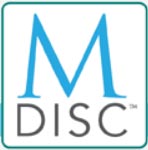
The M-DISC is short for Millennial Disc. It is a write-once optical disc technology that’s available in DVD and Blu-ray. It uses an inorganic metal oxide layer to store the data, which should have very long term stability compared to the organic dyes found in DVD and Blu-ray disks. Organic dyes start to degrade and fade as soon as they are written, leading to a condition sometimes called “data rot”. The National Archives warns that the reliable shelf life of a standard recordable DVD is only somewhere between 2 and 5 years. Like me you may have many discs that have lasted longer, but their useful life is finite.
Not all DVD or Blu-ray players will play an M-Disk. But M-Discs are readable by most regular disc drives. Be sure you purchase a DVD drive that supports M-Disc DVD. Or purchase a Blu-ray drive that supports both M-Disc DVD and M-Disc Blu-ray. They are called M-Ready drives. Look for the M-Disc logo. Here’s an inexpensive M-Ready drive on Amazon.
Update to the latest firmware for your drive. Out of date firmware may be one of the reasons for disks that will not play. The user reviews of the M-disk are pretty positive. On Amazon, the vast majority are four and five stars reviews.
The poor reviews are mostly about failure to play the disk, occasionally even with an approved drive that created it. Some users complained that they had to insert the disk several times for it to be read. One user wrote that “Five of the fifteen discs failed in verification.” The failures happened immediately so at least you’d know there was a problem. One possible reason for the DVD version having problems is that these are DVD+R disks which are not as reliable as DVD-R disk in common usage. This reminds me of the early days of DVDs when some clients could not view the DVD I created for them, but others could. Turned out those players were older models and that was usually the problem.
Like a conventional Blu-ray disk, the M-Disc Blu-ray can hold up to 25 gigabytes. But the M-Disc BDXL can hold up to a delicious 100 gigabytes. The burning rate is 4X so a DVD or Blu-ray will each take about 30 minutes. The manufacturer doesn’t recommend inkjet printing these disks, but rather hand-writing a simple name or serial number on the inner hub of the disc where no data is recorded. This is how professional archivists do it.
It’s wise to store the valuable data in more than one place such as on separate disks using different brands of top quality media such as Taiyo Yuden and Panasonic and on cloud storage like a Dropbox, Wistia or Amazon. These M-disks may finally solve one of the real downsides of video in general – it is not permanent. I’ve even seen some of my own family videos disappear and that’s a hard lesson to bear.
The drives are another question. No one knows how long Blu-ray drives will be around. 100 years? I wouldn’t bet on it. So an additional safety measure would be to transfer all materials to another permanent storage medium 20 years from now. Or at least before the last Blu-ray player is available.
Bottom line: Will M-disk Last 1000 Years? No one know for sure, but I do recommend M-Disks. I also recommend that you copy your important data to other storage containers.






Recent Comments